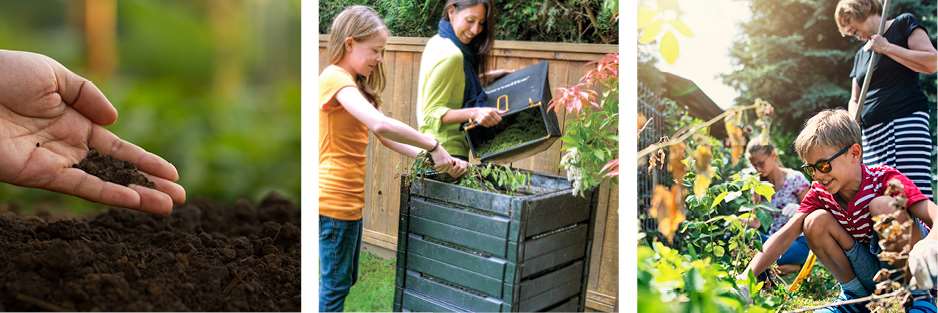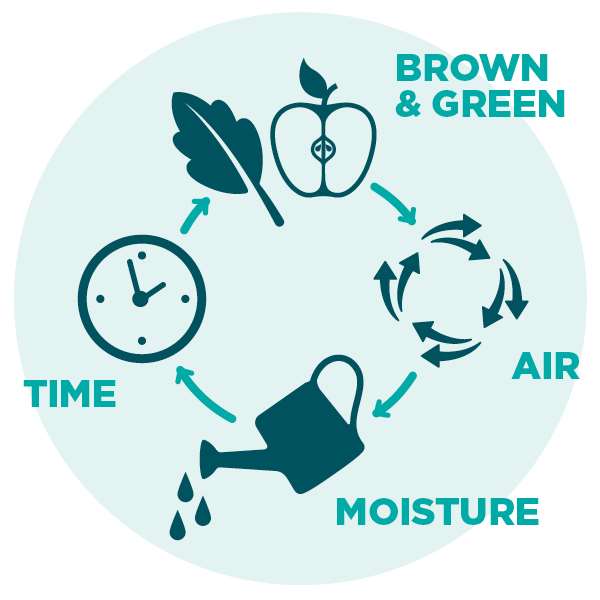Composting at Home
 Composting is a simple and organic process that can reduce household waste and when you add the nutrient-rich compost to the soil, it can help keep lawns and gardens healthy. Fruit and vegetable peelings, along with grass, leaves and other yard trimmings can be added to a compost bin. By following the simple steps provided here, Richmond residents can generate their own compost to enrich their garden soil.
Composting is a simple and organic process that can reduce household waste and when you add the nutrient-rich compost to the soil, it can help keep lawns and gardens healthy. Fruit and vegetable peelings, along with grass, leaves and other yard trimmings can be added to a compost bin. By following the simple steps provided here, Richmond residents can generate their own compost to enrich their garden soil.
Guide for Composting at Home
Simple Steps for Composting at Home
Materials to Add to Home Compost
Tips for Successful Composting
Using Your Compost
Common Compost Problems
Composting Resources
Compost Ingredients
There are four main ingredients in the compost recipe: compostable materials (brown and green materials for carbon and nitrogen), air, water and time.

Simple Steps for Composting at Home
1. Use a backyard compost bin
Richmond residents can buy bins at a discount from the Recycling Depot for $25 plus tax. The bins work well for composting grass, leaves, vegetable trimmings, fruit and other garden trimmings.
2. Start with a good base layer
Start by adding coarse organic materials such as straw, leaves or prunings at the bottom of the bin to allow air to circulate.
3. Alternate green and brown materials
Add nitrogen-rich green materials such as grass and garden trimmings, followed by a layer of carbon-rich brown materials, such as leaves and straw, until the bin is full.
4. Keep the air flowing
Turn and sir your compost weekly so the organisms get necessary oxygen.
5. Add water regularly
Compost requires moisture. Water your compost bin as required to ensure it stays moist as a wrung-out sponge.
6. Give it time
It generally takes 12-18 months for material at the bottom and middle of the bin to turn into compost you can use throughout your garden or on your lawn.
7. Harvesting
Harvest your compost when the compost at the bottom is decomposed and moist. Dig out the compost with a shovel, using the door at the bottom of the commercial bin; or if you have built your own, remove the top new layers and dig the compost from the centre.
Tip: When harvesting you may choose to sift your compost through a mesh screen to remove large chunks of unfinished material.
Materials to Add to Home Compost
| Nitrogen Rich Green Materials | Carbon Rich Brown Materials |
|---|---|
| Coffee grounds | Dry leaves |
| Egg shells | Sawdust |
| Flowers, cuttings | Shredded newspaper clippings |
| Fresh grass clippings | Shrub prunings |
| Fruit and vegetable peelings | Straw and hay |
| Lawn and garden trimmings | Wood chips/pellets |
| Seaweed and kelp | |
| Tea leaves |
Do Not Include These Items in Home Compost
- Dairy products
- Fats and oils
- Meat
- Fish
- Bones
- Metals
- Pet waste
- Plastics (including biodegradable/compostable plastics)
- Invasive plants including knotweed, giant hogweed, wild chervil and purple loosestrife
Tip: Invasive plants can spread quickly, taking over the natural environment and destroying animal habitats. Some also pose safety risks and need special handling when being removed. Please recycle these plants in your Green Cart or take them to the Recycling Depot. For more information visit richmond.ca/InvasiveSpecies.
Tips for Successful Composting
Here are a few ways to get your home composting set up off to a successful start.
- Set up your compost bin in an open area with drainage.
- The composting process works best when the materials are small. Chipping, chopping or shredding materials can increase the speed of the process.
- Avoid adding thick layers of any one kind of organic materials. Ideally, keep grass to less than 6 cm deep, and leaves to less than 15 cm deep.
- Water and airflow are both important for composting.
- To help prevent materials from compacting together (which limits air flow), it’s best to let grass dry first or mix it with dry, coarse material such as leaves to prevent compacting.
- Remember to turn and stir your compost weekly.
- Adding water regularly is key to successful composting.
- You can add materials to your compost bin all winter long. The breakdown process slows down or stops when the pile is frozen, but it will start up again in the spring. Thorough turning in the spring will reactivate the pile. Empty the composter in the fall to make plenty of room.
Using Your Compost
Compost is an excellent natural ingredient to improve your lawn and gardens. It provides nutrients to plants, conserves water, helps control soil erosion and can extend the growing season. Try these best practices for applying compost in your yard and garden:
Planters & Containers: Add to potting soil for all garden containers using a mix of 1/3 compost, 1/3 soil and 1/3 vermiculite, which is a gardening product that helps soil retain water.
Vegetable Gardens: Dig compost into vegetable gardens and mix thoroughly with soil.
Perennials: Spread compost so that it is 5 cm deep around perennials.
Lawn Care: After you aerate your lawn, rake 4 cm of compost over the surface.
Garden Care: Place compost around plants, shrubs and trees to conserve moisture, control weeds and provide nutrients.
Common Compost Problems
| Symptom | Diagnosis | Treatment |
|---|---|---|
| Bin has a bad odour. | Not enough air. Pile too wet. |
Turn pile. Add coarse dry materials such as straw or cornstalks. |
| Pile is dry throughout. | Not enough water. Too much woody material. |
Turn and moisten materials. Add fresh materials. Cover pile to reduce evaporation. |
| Compost material is damp and warm only in the middle. | Not enough material in bin. | Collect more material and mix the new ingredients into the old. |
| Material is damp and sweet-smelling, but not heating up. | Lack of nitrogen. | Mix in nitrogen-rich (green) material such as fresh grass clippings. |
| Pests are around compost bin (dogs, rodents, insects). | Improper food scraps added. Materials not covered enough. |
Do not add meat, fats, hones or animal waste. Use an animal-resistant compost bin. |
| Flies in compost bin. | Fruit and vegetable scraps not covered. Not enough brown materials. |
Put fruit and vegetable scraps in centre of bin and cover with soil or brown material. |
Composting Resources
Compost Demonstration Garden
To help residents learn about backyard composting, the City of Richmond offers a Compost Demonstration Garden in the Terra Nova Rural Park Centre located at 2631 Westminster Highway, just west of No. 1 Road. It is open from dawn to dusk year-round, and residents are encouraged to take a self-guided tour to learn about different types of compost bins and the benefits of composting.
Compost Bins
Home composting bins are available for purchase at the Richmond Recycling Depot. The bin dimensions are 32" high, 28" wide and 28" deep and are suitable for residential backyard composting of grass, leaves, vegetable trimmings, fruit trimmings and other miscellaneous organic garden trimmings.
- $25 Compost Bin (plus tax)
- $30 Rain Barrels (plus tax)
Compost Hotline
The Compost Hotline at 604-736-2250 offers tips and advice on how to compost and use the nutrient-rich soil for home gardens.

